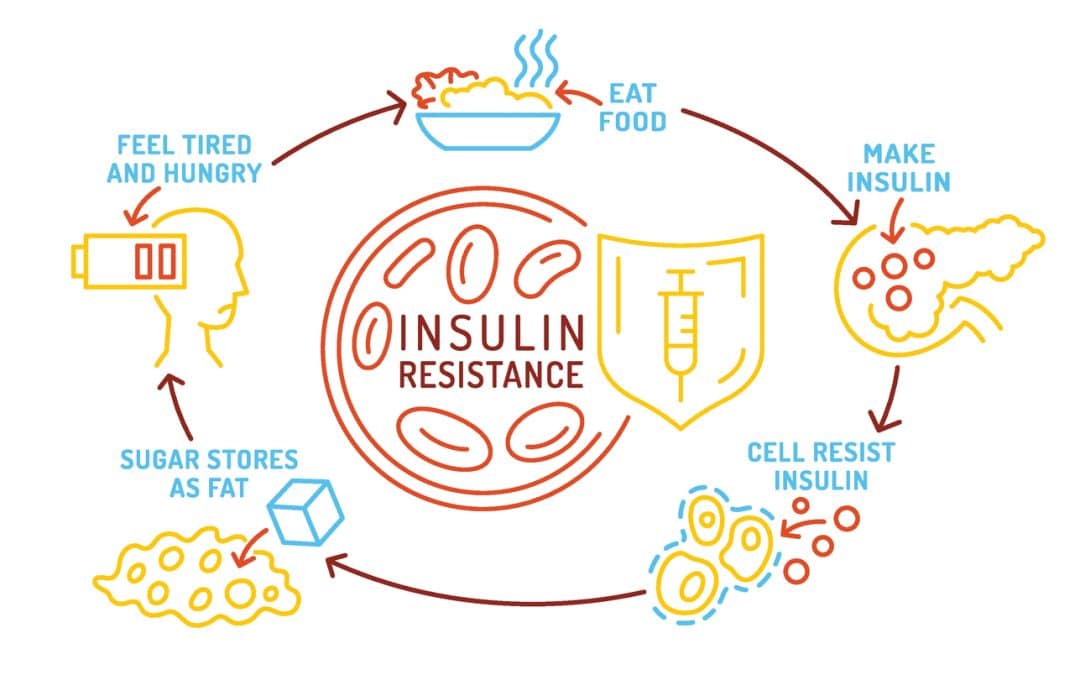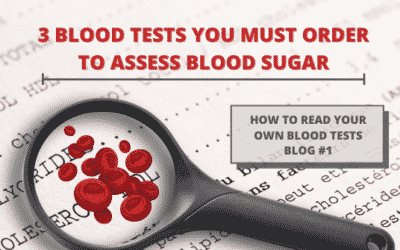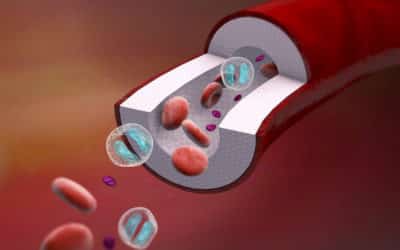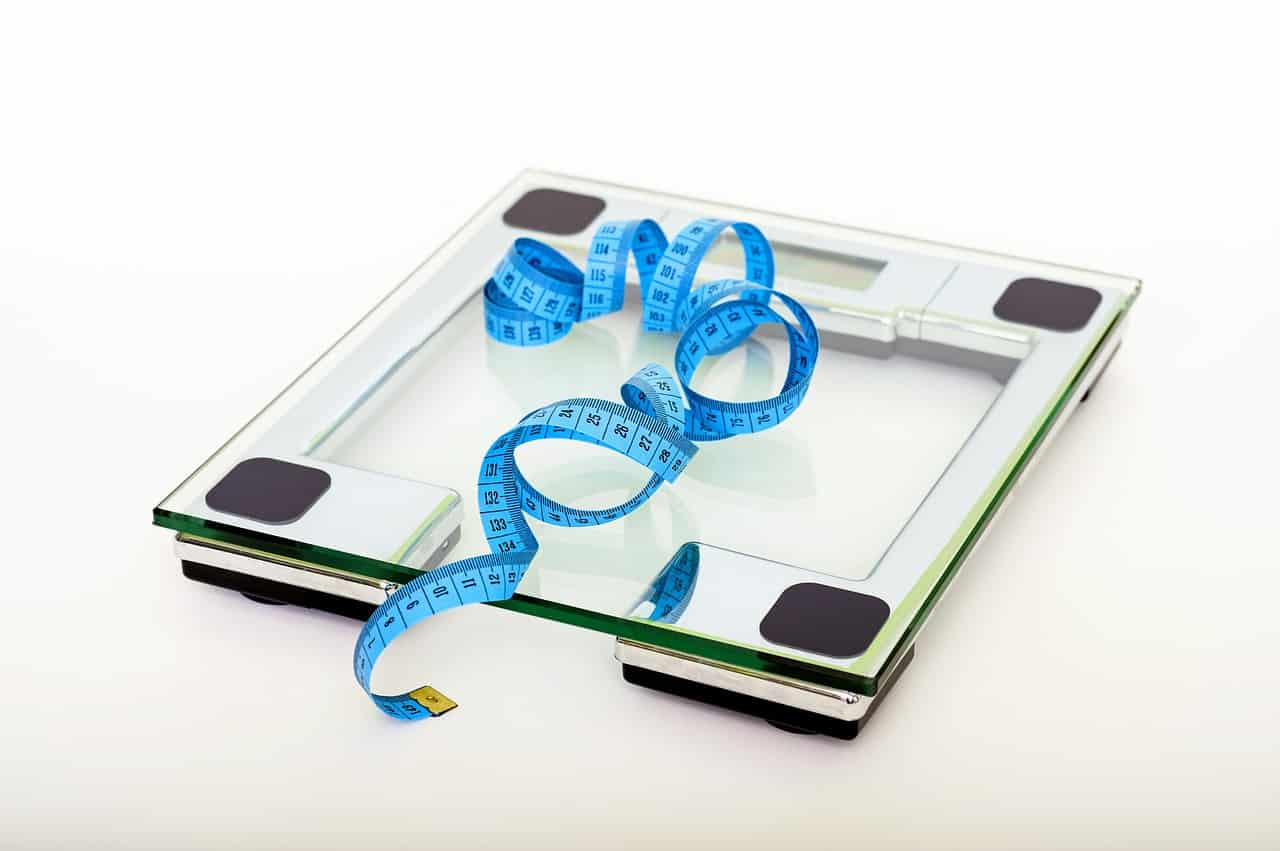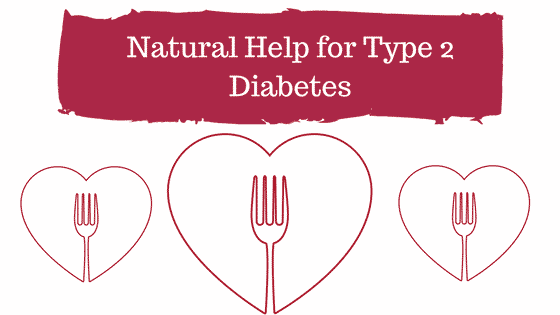One of the things we talk about often in our office is a monster of a problem called insulin resistance—and for good reason. It’s one of the most common yet overlooked root causes of issues like fatigue, stubborn weight gain, brain fog, hormone imbalances, and more. Even more concerning, insulin resistance is linked as a primary positive factor in fatty liver, heart disease, cancer, arthritis, Alzheimer’s, and chronic immune issues.
The good news? It’s nearly 100% preventable—and often reversible! In this article, we’ll explain what insulin resistance is, the symptoms to watch for, how functional lab testing reveals more than a standard blood sugar check, and the natural strategies we use in our clinic to help patients restore long-term health, energy, and balance.
What Is Insulin Resistance?
So, you ask, what exactly is insulin resistance?
When we eat, especially when we eat carbohydrates (a good form of carbohydrates is found in fruits and vegetables, but is more concentrated in grains and sugar, such as cakes, cookies, pies, pasta, rice, beans, candy, fruit, juice, and soda).
When we eat these carbohydrates, they get into our bloodstream (now called blood sugar), causing the release of insulin from our pancreas. Insulin shuttles blood sugar, along with other nutrients, into our cells. The more carbohydrates we eat, the more insulin we produce, because if we get too much sugar into our bloodstream, we can go into a coma. This is what happens with a diabetic coma.
Here is a great YouTube video from Khan Academy that explains how insulin works in the body.
How much carbohydrate is too much, you ask? At any given moment, we only have 10 grams of sugar in our bloodstream! That’s less than 2 teaspoons! So, as you can see, it’s very easy to over-consume carbohydrates, which jacks up our blood sugar, causing the release of huge amounts of insulin. This would be kind of OK if it happened once or twice a week, but what happens is we overconsume carbohydrates for breakfast, lunch, dinner, and snacks!
As our blood sugar keeps on going up, our body secretes more and more insulin in an upward spiral. Eventually, our cells say “NO MORE!” to all the sugar, by getting “resistant” to the insulin that our pancreas is producing.
But remember, too much sugar in the bloodstream is dangerous, and your body knows this, but what do we do? We keep eating sugar and carbohydrates, and our body produces more and more insulin to overcome the fact that our cells become resistant to it. Eventually, our insulin levels go higher and higher, and we develop severe insulin resistance.
Signs and Symptoms of Insulin Resistance
Insulin resistance often develops silently, long before blood sugar levels rise enough to show up on a standard lab test. But your body usually gives you clues. Some of the most common early signs of insulin resistance include:
- Fatigue, especially after meals
- Sugar and carb cravings
- Weight gain around the midsection
- Brain fog and difficulty concentrating
- Irritability or mood swings
- Trouble losing weight, despite dieting and exercise
These symptoms can affect both men and women, but they often show up differently depending on the person’s hormones and metabolic health.
In women, insulin resistance is strongly linked to hormonal imbalances such as PCOS (polycystic ovary syndrome), irregular periods, fertility struggles, and even hair thinning or acne. In men, it can contribute to low testosterone and poor metabolic function. In both cases, insulin resistance disrupts the body’s ability to regulate energy, mood, and weight—and it often goes undiagnosed for years.
Why Insulin Resistance Is Overlooked in Standard Medical Care
So, being as important as it is, why are doctors not treating it?
Well, the answer is that while insulin resistance often leads to diabetes, there is no drug treatment for it before it becomes diabetes.
Therefore, it’s virtually ignored by our Western medical system. And to make it even more ironic, the treatment for insulin resistance is free!
A low-carbohydrate diet, like the Page Diet that we have here in our office, along with just moderate exercise, like walking every morning for 20 minutes, will completely reverse insulin resistance in the vast majority of cases over time.
There’s some debate around what the optimal fasting insulin level should be—but many functional medicine practitioners agree that it should ideally be below 8. The problem is, most standard lab reference ranges list “normal” as anything under 24! Why? Because the average person is consuming so many processed carbs and sugars that chronically high insulin levels are becoming the new normal. Insulin resistance and disease are becoming normalized!
This is exactly why insulin resistance is so often missed in conventional lab work. Just because a number is “in range” doesn’t mean it’s healthy. Functional lab testing helps us look at optimal ranges, not just disease ranges—so we can catch metabolic imbalances long before they turn into full-blown conditions like type 2 diabetes, heart disease, or PCOS.
Functional Lab Testing for Insulin Resistance
Insulin Resistance is not appropriately tested for. You see, most people know about blood sugar, and just about all doctors know about blood sugar, and there’s an assumption that if your blood sugar is “normal”, then you’re fine. Nothing could be farther from the truth!
The fact is, fasting blood sugar is the worst indicator of blood sugar control, not the best! In fact, in one of the medical textbooks that we use, Mosby’s, it even points out that fasting insulin often elevates years before fasting glucose. (I’ve seen people come in who were completely diabetic with normal fasting blood sugar.)
But don’t take my word for it, read it right here. It’s not that we were taught the wrong thing, because it’s right there in our textbook. It’s that we’re not testing for the right thing.
So, what must we measure if we want to check for insulin resistance?
Well, the first thing you must test for is right there in the name, insulin. And it has to be fasting.
Knowing your fasting insulin is just as important as knowing your fasting glucose—maybe more important, because, like the textbook says, fasting insulin increases years before fasting glucose does. In other words, it’s the canary in the coal mine.
Fasting Insulin is also part of the formula known as HOMA-IR (short for homeostatic model assessment of insulin resistance)—we call it your insulin resistance score.
To calculate your HOMA-IR, just take your fasting glucose, multiply it times your fasting insulin, and divide by 405.
(Or just use this online calculator: The HOMA-IR – Insulin Resistance Calculator – The Blood Code)
This number should be one plus or minus 0.5 for optimum health.
I’ve tested this so many times on patients now, and what I’ve found is this:
If you have a score between 1.5 and 0.5, your fasting insulin should be less than 6. There you go, an easy way to cheat the system. Having a fasting insulin of less than six correlates to an optimum insulin sensitivity score about 90% of the time.
Now all you have to do is get your fasting insulin measured!
At Sheehan Natural Health, these markers our part of our standard functional lab tests that we order for every new patient.
Additional markers that we take into consideration are Hemoglobin A1c, HDL, and Triglycerides. I will talk about this in detail in another blog post. I cover these secondarily because way too many times people focus on them, instead of one of the most important markers, mainly fasting insulin and HOMA-IR. Don’t be one of those people. To measure insulin resistance, we have to do it right. It’s that important.
Natural Solutions for Insulin Resistance
So, what’s the cure for Insulin Resistance?
We’ve been practicing nutrition here in the office for the past 28 years, and I can tell you that there are a couple of different diets that work. First, I start people on what’s called the Page Diet.
This diet was studied by Dr. Page. What he did was take people’s blood tests and feed them different foods and retest their blood tests every couple of days over the course of two weeks. And surprise! What he found was that a diet high in vegetables, moderate in protein, fruits, nuts, and seeds, and extremely low in refined carbohydrates such as refined grains, sugars, juices, sodas, and such, balances people’s blood sugar in a hurry!
Add to this whole-body exercise—the easiest one being walking—for 20 to 30 minutes in the morning, and you have a one-two combo that hits every time!
For people with severe insulin resistance, such as diabetics, we use the same exercise program, but instead of doing the Page Diet, we use a diet called the “Free Foods” diet. It’s a list from David Mendosa of vegetables that are so low in carbs they are considered “free”, meaning you can eat as many of these vegetables as you want and it will not affect your blood sugar. This diet is very similar to keto, except that it allows a lot more vegetables. The carbohydrates in this list are so low that it takes more carbohydrates to process the food than they have in it! It gets the job done even quicker!
When to Seek Help from a Functional Health Clinic
If you’ve been told your bloodwork looks “normal”, but you still struggle with fatigue, weight gain, cravings, or brain fog, it may be time to dig deeper. Insulin resistance can be present long before glucose or A1C levels rise enough to trigger concern on a standard lab report.
At our clinic, we use our method, Nutritional Blood Chemistry™, which analyses functional lab tests in a specific sequence to get an overall picture of your body and key areas, and determine the cause or causes of health issues that are unique to YOU.
We use functional lab testing to evaluate early patterns of metabolic imbalance—like eleveated fasting insulin or subtle hormone shifts—so we can identify and address the root causes before they develop into chronic conditions. Whether you’re managing symptoms now or just want a clearer picture of your long-term health, personalized testing can make all the difference.
Curious about how our functional approach could help you? Schedule a free phone consultation with one of our practitioners—we’ll listen to your concerns and help point you in the right direction with next steps tailored to you.
Final Thoughts
By now, you might be wondering: Do I have insulin resistance?
If you’re already a patient in our clinic, chances are we’ve gone over this with you in detail. But if you’re not, the only way to know for sure is with lab testing—and not just the standard panels most doctors run.
At a minimum, we recommend starting with these key markers:
-
Fasting blood sugar – ideally below 85 mg/dL
-
Fasting insulin – ideally below 6.5 μIU/mL
-
Fasting triglycerides – ideally below 100 mg/dL
If any—or all—of these are above optimal levels, you likely have some degree of insulin resistance. The number and severity of elevated markers can give us insight into how advanced the issue is.
So, just to be clear, the defining lab test to clarify whether someone has insulin resistance is high fasting insulin. However, over 99% of medical doctors do not test for fasting levels of insulin. Why is this? Because there is no drug to treat high levels of fasting insulin, the only way to handle high fasting insulin is through proper diet and exercise. Other words, there is no money to be made in the prevention of insulin resistance—the treatment is free!
The bottom line?
Insulin resistance is common—but with the right information and support, it’s also completely reversible. You just need the right labs, the right guidance, and a personalized approach that focuses on root causes instead of just symptoms.
I hope this clears up what insulin is, what insulin resistance is, how to figure out whether you have insulin resistance or not, and how you can fix it yourself easily.
If you’re ready to take that next step, schedule a free phone consultation to learn how we help patients uncover and reverse insulin resistance—naturally.
Related Articles
The Page Diet: The Most Effective Diet For Overall Health
What is the Healthiest Diet? If you have been a patient of ours, you probably know there are many dietary strategies that can work very well to get you healthier and feeling better. The best diets out there minimize or eliminate processed foods and stress regular...
3 Blood Tests You Must Order To Assess Blood Sugar
Updated October 8th, 2020 Three blood tests you must order to assess blood sugar control properly. (Your doctor is most likely only tracking one, two if you’re lucky—but definitely not three!) If you have been reading my blog for a while, or are a patient of mine, you...
Part 2: How To Lower Blood Pressure And Prevent Heart Disease Without Drugs
Last week, we covered hypertension aka high blood pressure, explained why it’s a problem, and when medications may not be the best treatment approach for many people. Now, let’s take a look at some of the causes of hypertension. Causes of Hypertension 1....
Hypothetical Case Study #1 Obesity and Metabolic Syndrome
Hypothetical Case Study #1: An Approach to Obesity and Metabolic Syndrome By Laura Sheehan I am going to discuss my hypothetical client Marilyn. Marilyn has come to me for nutritional help, with the goal of making dietary modifications to get off her medications. She...
5 Things You Can Do to Improve (or in most cases, reverse!) Diabetes
If you’ve been diagnosed with diabetes, you might be wondering what you can do to help it. Personally, in our office, when we have put a patient with Type II diabetes on a personalized diet and supplementation program, we’ve seen people dramatically reduce their...
11 Ways to Lower Insulin
So by now you’ve probably watched a number of my videos, and/or read my articles, and know that we mainly focus on cutting down refined carbohydrates and sugars in the diet, to cut down the body’s secretion of insulin, to help return your health. You know high...
Dr. Sheehan’s Natural Help for Type 2 Diabetes
Do you, or a loved one either have Type 2 diabetes, or what is called Pre-Diabetes, aka Syndrome X? I have a lot of patients coming in with these two disorders, so before I talk about it, I decided to look into exactly what the American Diabetes Association is saying...

